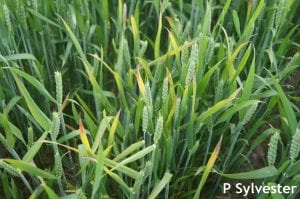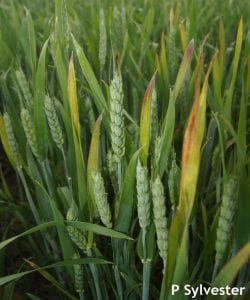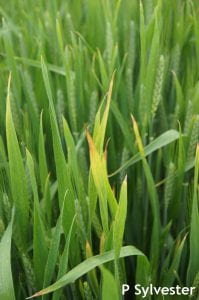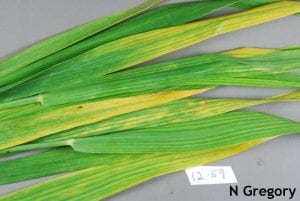Phillip Sylvester, Kent Co., Ag Agent; phillip@udel.edu, Joanne Whalen, Extension IPM Specialist; jwhalen@udel.edu and Nancy Gregory, Plant Diagnostician; ngregory@udel.edu
As we approach the upcoming small grains planting season, it is a good time to discuss barley yellow dwarf management. Barley yellow dwarf (BYD) can be found most years in a few wheat fields in Delaware. It is not uncommon to see a few infected plants, primarily in the spring. In 2012, the number of fields with infected plants appeared to be generally higher compared to most seasons. Impact on yield was variable, though it was estimated that some fields experienced a 5% yield loss. The dry spring weather in Delaware had a larger impact on yield, therefore it was difficult to estimate the true impact of BYD. It is important to understand the causal agents, symptoms, and disease cycle in order to best manage BYD. Barley yellow dwarf is the most widespread virus disease of cereal crops worldwide and can infect other crops such as rye, barley, oats, and corn, though the greatest concern in our area is in wheat.
Causal Agents
There are numerous virus types that actually cause BYD. While the taxonomy of BYD can be complicated, it’s important to note that some strains are more severe than others. The ones that are of greatest concern in our area are (in order from least severe to most severe): BYDV-MAV, BYDV-PAV (severe strain), and CYDV-RPV. CYDV-RPV, cereal yellow dwarf, was named and then later found to be a related strain of BYD. Both CYDV-RPV and BYDV-PAV were confirmed in the samples submitted this past spring from wheat fields in Delaware.
Vector
The BYD viruses are limited to the phloem and can only be transmitted from plant to plant by aphids which have piercing/sucking mouthparts. The infection occurs after aphids feed on infected hosts, such as wild grasses, and then move into and feed on wheat fields. The wild grasses may be infected yet show no symptoms. It can take as little as 12-48 hours from the time aphids feed on the infected grasses until infection has occurred in wheat plants. This can occur anytime that aphids are actively feeding, which would typically be in the fall and spring months when the weather is warmer. Since the spread of barley yellow dwarf depends on aphids, management of the aphids may be helpful in fields with known problems of barley yellow dwarf in the past. Remember that the viruses causing BYD are only transmitted by aphids and are not known to be seed-borne. Read the Aphids Prevention and Barley Yellow Dwarf Management article in this issue of WCU for more on management.
Symptoms
Symptoms include leaf discoloration (Figures 1- 3), shortening of the internodes, and general stunting of the plant. Leaf discoloration typically has a characteristic purple to yellow color. Symptoms become exacerbated by cool weather and high light intensity. Hot spots (cluster of infected plants) may occur near field borders, field corners, or near woods depending on how the aphids moved. To further complicate matters, the plant’s reaction to the infection may vary depending on when the plant was infected and the variety of wheat. Fall infections usually result in more stunting and less tillering while spring infections tend to discolor the flag leaf and are thought to cause little yield loss. Other viruses such as wheat spindle streak and/or wheat soil-borne mosaic virus may infect the plant causing additional symptoms (see Figure 4). The other viruses are not transmitted by aphids. To learn more about the other viruses we encounter in Delaware, read Bob Mulrooney’s article on Viruses in Winter Wheat at: http://extension.udel.edu/weeklycropupdate/?p=2745. It’s difficult to identify viruses in the field and samples should be submitted to a lab for testing to confirm virus infection.
 Figure 1. Wheat plant infected with barley yellow dwarf (BYDV-PAV).
Figure 1. Wheat plant infected with barley yellow dwarf (BYDV-PAV).
 Figure 2. Wheat plants infected with barley yellow dwarf (BYDV-PAV).
Figure 2. Wheat plants infected with barley yellow dwarf (BYDV-PAV).
 Figure 3. Wheat plants infected with barley yellow dwarf (BYDV-PAV).
Figure 3. Wheat plants infected with barley yellow dwarf (BYDV-PAV).
 Figure 4. Wheat Plant infected with BYDV-PAV, CYDV-RPV, wheat spindle streak mosaic virus, and wheat soil-borne mosaic virus.
Figure 4. Wheat Plant infected with BYDV-PAV, CYDV-RPV, wheat spindle streak mosaic virus, and wheat soil-borne mosaic virus.
 Figure 5. Close up of wheat infected with BYDV-PAV, CYDV-RPV, and wheat spindle streak mosaic virus.
Figure 5. Close up of wheat infected with BYDV-PAV, CYDV-RPV, and wheat spindle streak mosaic virus.
